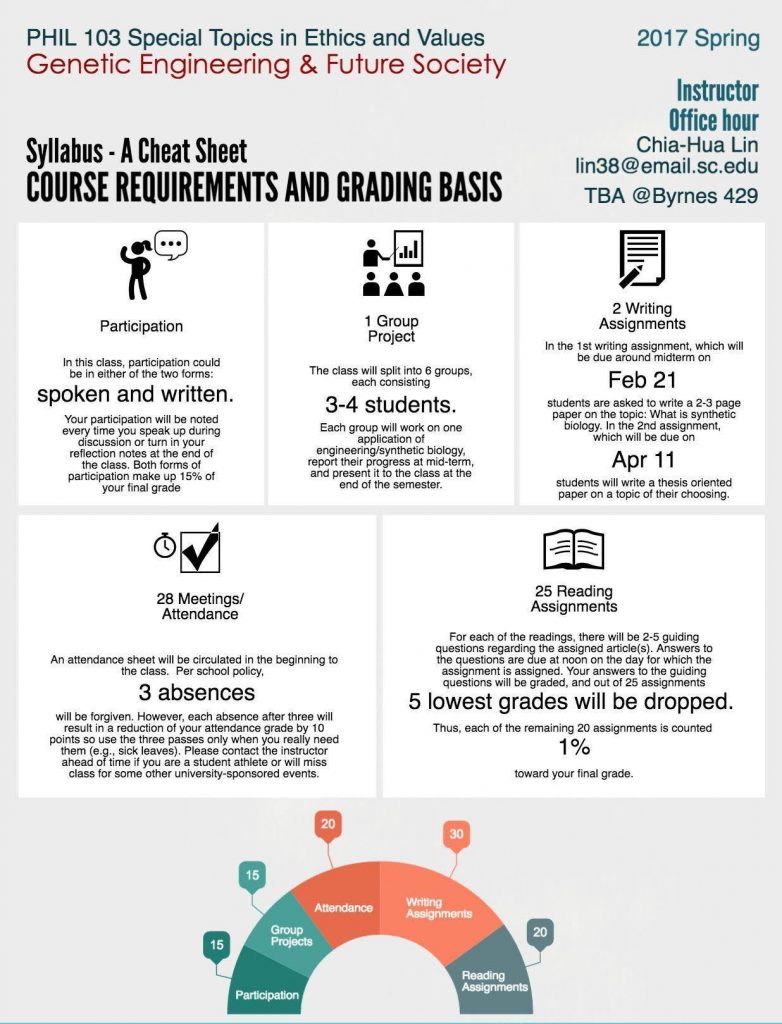Philosophy Syllabus As Infographic
“It’s in the syllabus,” we tell our students—so often there should be a t-shirt. Oh wait, there is. But perhaps we could make that information easier to spot? ChiaHua Lin, a PhD student in philosophy at the University of South Carolina, tries to do so by creating infographic supplements to her course syllabi. They highlight some of the important information about the course.
Here’s one she did for her applied ethics course, “Genetic Engineering and Future Society”:
I’d be interested in learning about other examples or models of unconventional syllabi that are or could be used in philosophy courses. If you have or know of one online, link to it in the comments. If you have one that’s not on a website somewhere, email it to me and I will add it to this post.




It would be interesting to know what tools faculty who make such things use. The results certainly look snappy, but I have a hard time assessing whether this is something most of us could actually do, efficiently, with the tools/software we have or can easily afford.
These two pages of infographics were made using freely available tools online provided by piktochart.com. According to the website’s front page, it aims to offer “Easy-to-Use Infographic Maker. Take your visual communication to the next level, without hiring a professional designer.” While I am not ready to claim that there is no learning curve at all, learning how to use piktochart would not be harder than, say, learning the recently updated MS Office 2016 if one knows MS Word from the 2010s. More importantly, Piktochart is one of the increasingly many free infographics makers online, which makes a low bar for creating an infographic syllabus, just a matter of time. To me, the process of thinking about what to highlight (from my 4-page long syllabus) took much longer than actually visualizing it. But if I can’t/won’t do the highlighting for the students, who am I to judge when they neglect it? In the end, the infographic supplements are not made just to look pretty or fancy; it is part of the effort made to communicate with the students more efficiently.
Nice, thanks for the info!
You are more than welcome!
Try canva.com
I’ve seen a few professors use a blog as their course syllabus with great success. Also, a few years ago I put together a list of digital humanities resources for the grad students in my department: http://melissajacquart.com/teaching/resources-for-instructors/digital-philosophy/. (and at the bottom of the page you’ll find a link to an example blog as a syllabus). I created this page a few years ago, and since then I have found some new tools I’ve been meaning to add to the lists. But I think this still is a decent starting document for anyone interested in knowing what digital humanities tools are out there.
I always felt that the key to a good syllabus was brevity. This looks very nice.
Sadly, my institution requires rather a lot of information is on the syllabus, including a can specifically formatted front page and information about extensions. So Im not sure I have the flexibility to do this but I’ll certainly look at the tools.
Here is a sample infographic syllabus that I created last year for my logic class, my very first try.
https://magic.piktochart.com/output/10189236-p110-syllabus
My students love my infographic syllabus! The number of syllabus-related questions I’ve had to answer has gone down significantly as well. I recommend canva.com–the first time I built one, it definitely was anything but efficient, but now I have a template that works for most courses I teach.